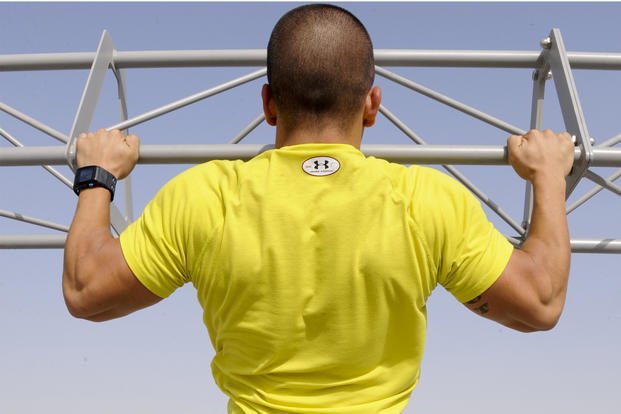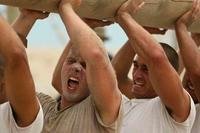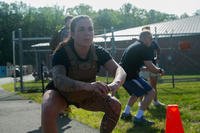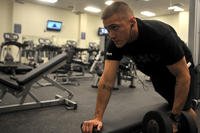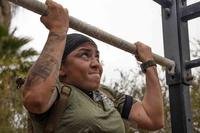I have had several emails that require short and sweet answers, so I have compiled a list of the top five questions that were most commonly asked. Here are the five most commonly asked questions:
1. Are pull-ups and dips considered resistance training?
Yes. Any weight, even your body weight, is considered resistance training. If you are a person whom the doctor or trainer recommends adding resistance training into your program, chances are you are probably only doing cardio workouts or a beginner to exercise.
Resistance training is moving various joints of your body through a full range of motion with applied force on them. Some examples: weight training (machines, dumbbells, or barbells), calisthenics (push-ups, dips, crunches, pull-ups, squats, and lunges -- the resistance is the force of gravity), rubber bands and even common household chores such as yard work.
The best part of resistance training is that you will burn more calories in the long run and build muscle fibers, which, in turn, will increase your metabolism more so than cardio alone. You still need your cardio for cardiorespiratory benefits and fat burning, but resistance training will enhance your results significantly.
2. Which kind of crunch is best for targeting the abs where the navel is?
I recommend doing a group of exercises that not only target the stomach muscles, but also help balance out your torso by focusing on lower-back muscles, too. Any time you do abdominal workouts, you always should add lower-back exercises to the equation. See one of my favorite articles, "Resting with Crunches," for more ideas.
You have to treat your stomach muscles as one wall of muscles that are affected by any movement that brings your sternum and pelvis closer together. Therefore, it is difficult to isolate any particular area of the upper, middle and lower abs because that all works together.
3. I am former military and currently a large metro-area police officer. Can you help me with "How to Get in SWAT Shape"? I need to focus on how a patrol officer can get himself in shape to join the SWAT team.
Funny you should ask that. I just came out with another book titled "The SWAT Workout" that helps a full range of police officers, from recruits to SWAT team members.
See The SWAT Workout at amazon.com or purchase it at a local major bookstore.
This book has more than 25 weeks of workouts in it and focuses on programs for recruits to ace the police academy and for active police officers to prepare for SWAT training or other emergency response teams (ERT). It's also a SWAT team maintenance plan.
It was developed from more than five years of training law enforcement officers at every level to prepare for various PT tests. The best advice is to make time before your police shift to work out. Seven out of 10 people decide not to work out after a long day's work, even if it was planned. Running, upper-body strength and stamina are highly emphasized in any special tactics team. Read some of the articles in the Military.com article archive for ideas on how to get started on your own.
4. I am not quite clear about the 100 pull-up workout you have in one of your articles. You write, "Try this workout -- 100 pull-ups in as few sets as possible. Rest with 100 abs of choice and 50-100 push-ups, then repeat pull-ups for the next set until you reach 100 pull-ups." Do you do 100 pull-ups first, then do abs and push-ups, and then repeat another 100 pull-ups?
No. The goal in this workout is to reach 100 pull-ups in as few sets as possible with active rest between sets. For instance:
-
Do max pull-ups until you fail.
-
"Rest" with max push-ups for one minute.
-
"Rest" with your abs of choice for one minute.
-
Optional quarter-mile run in 90-100 seconds
Repeat above as many times as necessary until you reach 100 pull-ups, then you are finished.
5. When swimming with fins, what fins do you recommend? Did you have UDT Duck Feet or Rocket Fins?
If you are training to go to BUD/S, PJ, Ranger or another Special Ops group that requires swimming with fins, you probably will be issued with UDT Duck Feet or U.S. Diver Rocket Fins. Since you will get these for free, buy a nice pair of fins for yourself that are comfortable for open-water swims or SCUBA diving.
Any dive shop will have some to try, but you have to get the kind of fins that require booties (dive socks) so they have a large foot well. I like Cressi Frog Fins or Mares Power Plana. If money is tight, you can find these on eBay for under $25-$30.
Stew Smith is a former Navy SEAL and fitness author certified as a Strength and Conditioning Specialist (CSCS) with the National Strength and Conditioning Association. Visit his Fitness eBook store if you're looking to start a workout program to create a healthy lifestyle. Send your fitness questions to stew@stewsmith.com.
Want to Learn More About Military Life?
Whether you're thinking of joining the military, looking for fitness and basic training tips, or keeping up with military life and benefits, Military.com has you covered. Subscribe to Military.com to have military news, updates and resources delivered directly to your inbox.
